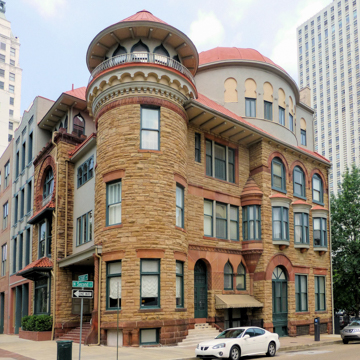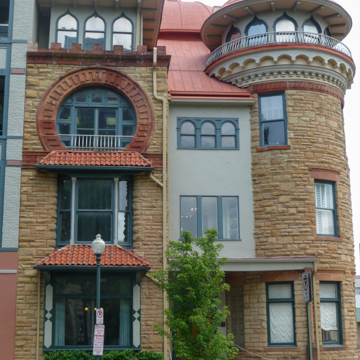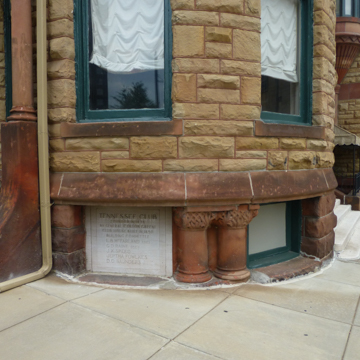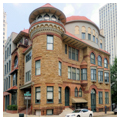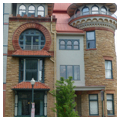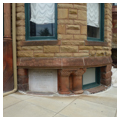The Tennessee Club was organized in 1875 by a group of men eager to re-establish traditional Southern society in Memphis following years of occupation by Union military forces. The founding group included former Confederate officers, most notably General Colton Greene (1833–1900), who survived four years of combat as a cavalry officer in the trans-Mississippi theater of the Civil War to become a successful banker and insurance agent. Cofounder of the Memphis Public Library, Greene was the civic leader who determined that the Tennessee Club should include a library and an art gallery. The club was also host to civic and scientific lectures, as well as social events like debutante balls. Multipurposed in conception, the facility included a sizeable kitchen, ballroom, apartments, and lounges. Its location at the Southeast corner of Court Square planted it firmly in the political and commercial center of the city.
The eclectic style of the club’s architecture reflected its eclectic institutional nature. The building is topped with a conical tower at the corner, featuring a ring of ogee-arched windows evoking eighteenth-century English notions of a Gothic turret. Behind the tower on Court Avenue is a dormer supported by Mission-style brackets. The most remarkable feature of the roof is the large dome resting on blind horseshoe-arched windows, presumably Moorish in inspiration. These arches are echoed on the Court Street elevation by a large Moorish window on the third floor. Squat Romanesque columns are at the base of the corner tower between the cornerstone and a basement window. Above the Second Street entrance are two more ogee-arched windows and an oriel window set into the corner of the second floor. Also marking that floor are three serial bow windows, a motif used by contemporary British Arts and Crafts designers.
Researchers in the 1980s identified the architect as “Edward Terrell,” but the designer was most likely Elah Terrell (1853–1920) of Columbus, Ohio. Though Terrell is an elusive figure, we know was he was active as an architect from about 1882 until 1892. During these years he designed several Romanesque Revival buildings: a high school (c. 1888) in Elyria, Ohio, and, in Columbus, the Norwich Hotel (c. 1890) and the Board of Trade Building (1889). The latter involved a peculiar brick vault supported with an iron ring of Terrell’s own invention. The vault failed during construction, killing two men and mangling a third. Though the Board of Trade building was eventually completed (destroyed 1969), the event may have caused Terrell to seek work outside Ohio, and soon after the Board of Trade disaster, he received the Tennessee Club commission. It, too, involved unusual vaulting, in the fourth-floor dome, but the vault was executed in wood rather than brick.
In a manner similar to his work in Ohio, here Terrell used red sandstone, roughly dressed, accented with a smooth red stone trim. The building was originally topped with a Mission-style red-tile roof, now sheathed in red metal. The awnings facing Court Avenue retain their original tiles. Before they were enclosed, there were open balconies on the second and third floors facing Court Avenue.
From one of those balconies, Carrie Nation delivered an impassioned speech in 1908 in support of prohibition, leading to the breaking of bar windows along Beale Street. Other notable guests of the club included presidents Theodore Roosevelt and William H. Taft. One of the meeting rooms, the “Crump Room,” was named for Edward Hull “Boss” Crump, the mayor of Memphis and long-time member of the U.S. House of Representatives, who used the Tennessee Club for many of his political meetings.
In 1970 the building was purchased and later restored by the law firm of Burch, Porter and Johnson. The building has since served as a law office.
References
Betti, Tom, and Sauer, Doreen Uhas. Historic Hotels of Columbus, Ohio (Landmarks). Charleston, SC: Arcadia Publishing, 2015.
Lee, Alfred Emory. History of the City of Columbus, Capital of Ohio. Vol. 2. Columbus, OH: W. W. Munsell and Company, 1892.
Ostby, Lloyd, and Bennett, Ann, “The Tennessee Club/Overall-Goodbar Building,” Shelby County, Tennessee. National Register of Historic Places Inventory–Nomination From, 1982. National Park Service, U.S. Department of the Interior, Washington, D.C.
Patton, William. A Guide to Historic Downtown Memphis. Charleston, SC: Arcadia Publishing, 2011.














